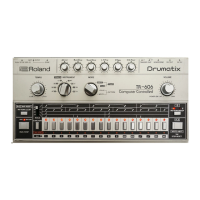ADVANCED
COURSE (Cont'd!
(Tjisdepressiid.
you
will
see the quarter notes
(beats) displayed
on the row of
LEtOs. For
Scale
#1
the
LED displays
show
every fourth
LED
lit.
It is
now
necessary to
choose the number of
steps
of
which
the
measure
will
consist. While
holding
down
the FUNCTION
button®, press
the
Selector
Switch
corresponding to
the last
step
of the pattern
(which in this
case
is
16).
You
haue now sat up a
Rhythm Pattern
consist-
ing
of sixteen steps,
with
each beat
(quarter
note) consisting
of four
steps.
Step Programming
Cfioose
an
instrument
sound to
be programmed
by
rotating
the
TRACKyiNSTRUMENT
selector
(Q)
(located next to
the MODE
selector
(§)).
It
is
usually
easiest to
program a Rhythm
starting with
the Bass
Drum, so
rotate the
selector to BD.
On the Program
Score
1
,
you
will
see
BD is
to
be played on Steps
1,7,11.
and
15,
so
touch the SELECTOR
Switches (K)
that correspond with
these
Step
^4umbers
described below
ttiem.
As
is
the case
with
many of
the
controls on
the
TR'606. the SELECTOR
Switches (K) serve a
dual
function
that
is
both choosing Rhythms
to
be
played and also
programming the Rhytlim
itself. You should
now
hear
the Bass Drum
sound on
those
Stops that
you selected.
If
this
is
not the case, go back to
the
beginning
of this
section and
repeat the process. When
the Bass
Drum
is
sounding properly, switch
the
TRACK
/INSTRUMENT
selector
©
to
SD,
and
program the Snare Drum as
it
indicated on
Ifie
Program Score 1 at
Steps
5, 13,
and
14.
Continue programming
the
other inslrument
voices
indicated
on the Program Score. It may
be easier for you to
program if
you adjust
Itia
TEMPO
to a slower speed.
If
you
niake
a
mistake and press Itie wrong switch, simply
press
it
again and the LED
will
go
out
indicat-
ing it
lias
been cancelled.
It is
possible
to clear all 16
steps of any select-
ed
voice by pressing
the CLEAR/RESET
but-
ton
(F) until all the notes
are erased.
This saves
lime when clearing
voices that have
been programmed on every
step.
TAP
Programming
While
most of the programming is
done
using
the
Step
method, it
is
also
possible to
program
in real time by
a
Tap
method. While the
Rhythm just
programmed
is
running, return
the
TRACK/INSTRUMENT
selector
©
to SD and
cancel
the Snare
Drum
sounds you
programmed
by
pressing
the CLEAR/RESET
button (F).
You can now re-program
the Snare
Drum
simply by pressing
the TAP
button (M) at
appropriate
places
in
the
measure. Wherever
you pressed the TAP
button (M),
there
will
automatically be
programmed a Snare
Drum
sound.
If
the Tapped Rhythm
is
out of SYNC
with the
others, it
can be erased just
the same as
whan
it is
programmed in
the
Step
method. Some-
times it may
be easier to use
the TAP
@
method when
the Rhythm
is
running fairly
slowly as synchronization
is
easier.
You have
just
programmed
your first Rhythm
into
the
Tf^-606.
This
Rhythm will
be stored
in memory and
can be edited at
PATTERN
WRITE
position.
Steps
and
Programming
With the TR-60B,
each
measure
is
divided into
a certain number
of parts
wfiich we call STEPS.
The Rhythm
you just
programmed
used
a 16
Step
measure,
whicli we
played in 4/4 time.
Tlierefore the
measure was
comprised
of four
quarter notes,
each qiiarier
notes was compris-
ed of four sixteentli
notes and
each sixteenth
note corresponding
to one STEP.
So, tor each
Siep
in
Program Score
1
,
each
Instrument
Voice had
either a beat
or a rest.
(Ttie
rest is
added
automalically
when you do
not
(jrogram
a
beat
in
that
place.
Fig. 3
Steps
1 2 3
4
5 6 7 a 9
1QUliiyi41blti
The Program Score
is
a
transcription
of the
music
score using the system
that
indicates
the
minimum
number
of notes
and rests.
However,
it is
not completely
musically
accurate
in
that
a
quarter note, for
example,
when
transcribed
to
the Program
Score from a
music score,
written as a
sixteenth note,
followed
by
three
rests.
This
also follows for
whole
notes, half
notes
and
eight
notes as
well.
25

